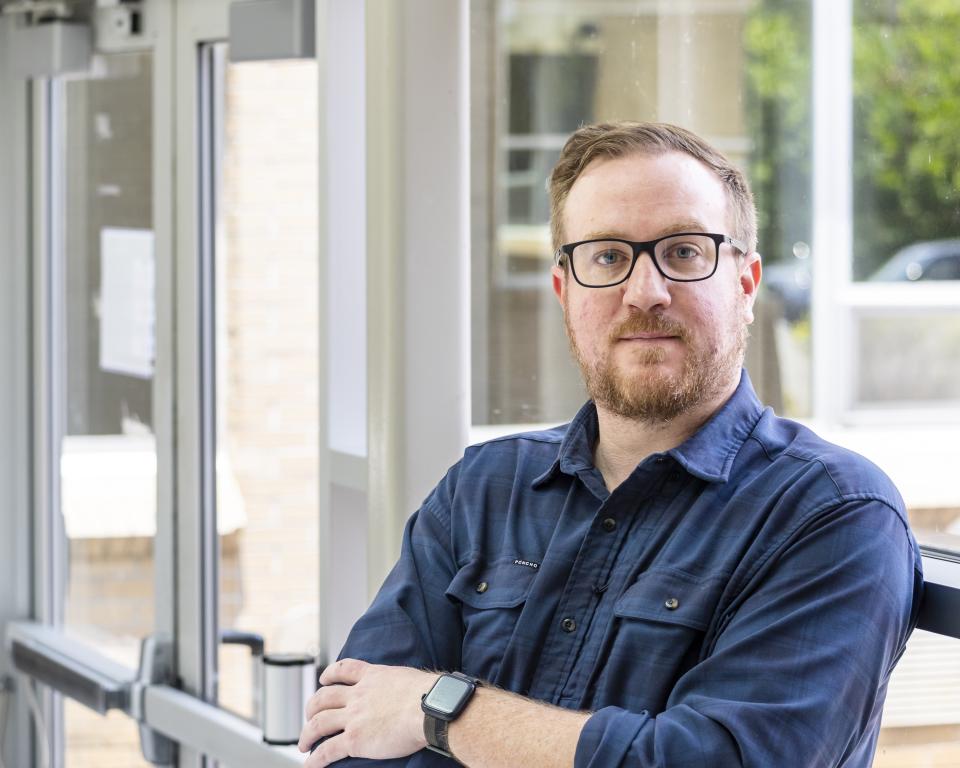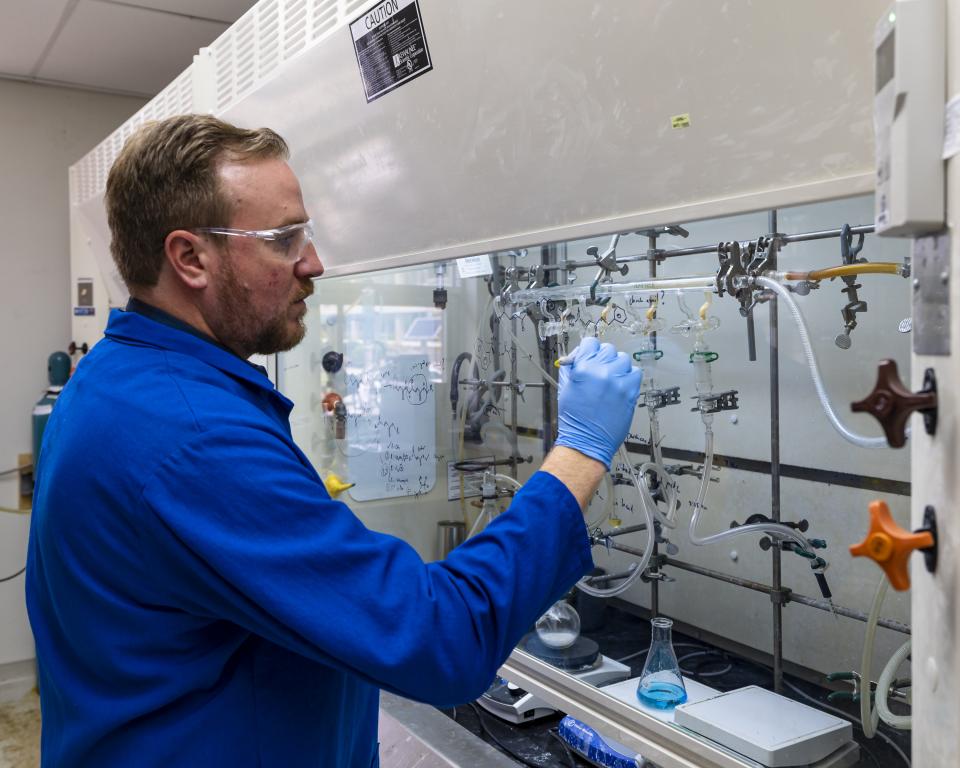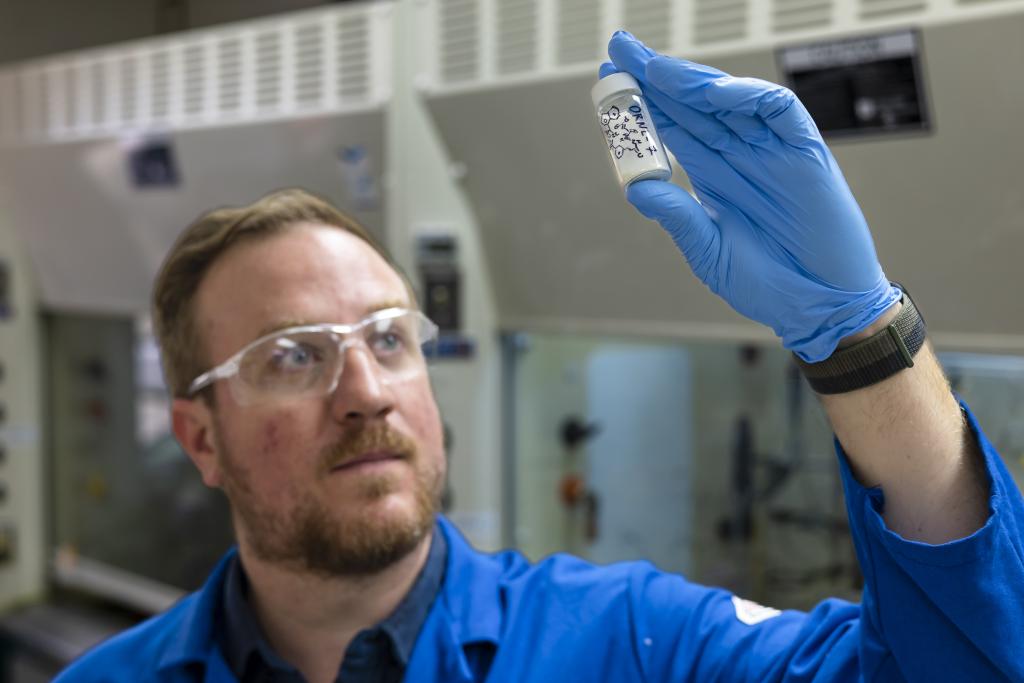
Brian Sanders is focused on impactful, multidisciplinary science at Oak Ridge National Laboratory, developing solutions for everything from improved imaging of plant-microbe interactions that influence ecosystem health to advancing new treatments for cancer and viral infections.
Sanders, associate staff scientist in the Biosciences Division, leverages his knowledge of chemistry and biology to study complex biological systems and to design molecules and nanoparticles for specific functions. One of the first projects he collaborated on at ORNL was the design of a molecule that disrupts the infection mechanism of the SARS-CoV-2 coronavirus, opening a new treatment pathway for COVID-19 and other viral diseases.
More recently, Sanders won an award through ORNL's Early Career Development Program to develop a non-destructive method of viewing belowground interactions between microbes and plants. He's using Prussian blue nanoparticles - microscopic, blue-colored particles derived from a substance used in paint pigments - to create contrast probes that work with magnetic resonance imaging and neutron imaging, giving scientists better resolution to analyze intact, dark soil environments.
"With these contrast probes, we hope to achieve a selective contrast for MRI and neutron tomography, similar to how contrasts are used in medical MRIs," Sanders said. The method can help accelerate the development of more resilient plants as bioenergy crops.
The award is more than just project funding. The ORNL Early Career Development Program provides networking opportunities, professional training and development, and increased understanding of the Department of Energy and its national laboratory system.
Visits with scientists and leadership in other directorates provided by the program "are a great opportunity to meet new people and connect the dots for collaborations," Sanders said. "You get a better understanding of what's going on across the lab."
"The lab is such a massive entity," Sanders added. "I'm always impressed when driving into work, thinking about how in just one building there are all these cool toys to do science with and they are at our disposal. You can send a couple of emails or run into people on campus and come up with exciting ways to collaborate. ORNL is a unique place to do science."

Guiding radiopharmaceuticals
In another project, Sanders is working to design biological molecules that recognize defective cells to deliver a precise radioisotope payload for cancer treatment. One of the aims of the Accelerating Radiotherapeutics through Advanced Molecular Constructs, or ARM initiative, is to advance the development of constructs to deliver medical isotopes to specific tumor cells, while minimizing exposure to heathy tissue. The project integrates ORNL expertise in isotopes, chemistry, biology, materials science and modeling and simulation - the kind of cross-cutting work that Sanders finds especially motivating.
"Strategically, ARM is a very exciting project," Sanders said. "ORNL has the unique ability to generate medically relevant radioisotopes, and now we're building the infrastructure to design new, potential therapies for several kinds of cancer. Not everyone has a nuclear reactor in-house. The combination of these capabilities is very powerful."
Sanders has likewise been working with colleagues in the ORNL-led Plant-Microbe Interfaces Scientific Focus Area, studying lipid-containing carbohydrates called lipo-chitooligosaccharides that act as signaling molecules to understand how plants and microorganisms such as fungi communicate and establish beneficial partnerships. The project's focus is on poplar - a fast-growing tree of interest as a hardy, perennial biomass crop.
In a recently completed project, Sanders worked with ORNL scientists to explore biological methods such as protein engineering to source critical materials. They developed a high-throughput approach that leveraged single-particle mass spectrometry to advance methods for the recovery and recycling of platinum.
Oak Ridge native son
Sanders is an Oak Ridge, Tennessee, native who grew up hearing about ORNL, including projects that his civil engineer father supported in the region. After high school he studied at the University of Tennessee, Knoxville, as an undeclared student, exploring courses as wide-ranging as art and anthropology before settling on chemistry.
"In my second UT chemistry class, a professor remarked that chemistry boils down to the movement of electrons. I found that to be very thought provoking," Sanders said. "It's what life boils down to as well; chemistry is what makes life happen." During his undergrad, he interned at ORNL in the Biosciences and the Metals and Ceramics divisions.
Sanders went on to pursue his doctorate in chemistry and bioinorganic chemistry at the University of Georgia with a focus on metals in biology. Those studies led to a National Institutes of Health Postdoctoral Fellowship at the California Institute of Technology, where Sanders worked with Harry Gray, a well-known chemist and spectroscopist in the same field.
"At Caltech I studied electron transfer in proteins, and so it became a bit of a full-circle moment," Sanders said. "I was inspired by chemistry being the movement of electrons, and then ended up studying how that works in biology - the mechanisms and importance of those processes."

He was hired as a staff scientist at ORNL in 2019. Looking forward, Sanders said he's interested in pursuing more opportunities to understand and utilize metals to answer biological questions. This is an area he pursued in his academic studies and which he sees as particularly relevant in addressing issues such as nutrient cycling, novel characterization techniques and metal binding and delivery techniques for radiopharmaceuticals.
Curiosity and collaboration
His advice for young scientists? "Seek out and develop good relationships with mentors, and always be willing to do new things in science. Step outside of your comfort zone and try new approaches. It can lead you to things that you would never expect or even thought possible. Don't be afraid to try a 'Friday experiment,' as we used to call them in college. Something that's not your main project, but it might be peripherally related so you try a new experiment and see if it works out. Be curious."
Curiosity and collaboration are concepts that encourage an outstanding experience at ORNL, as Sanders describes it.
"The collaborative nature of our work is fantastic - all the facilities, instrumentation and the many people here who are excellent in their field and sit down the hallway or in the next building. It's very cool to be able to connect with these people and have new science on the burner, and hopefully develop some really cool technologies," Sanders said. "That's what's exciting to me here."
UT-Battelle manages ORNL for DOE's Office of Science, the single largest supporter of basic research in the physical sciences in the United States. The Office of Science is working to address some of the most pressing challenges of our time. For more information, please visit energy.gov/science.






